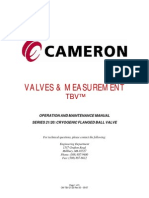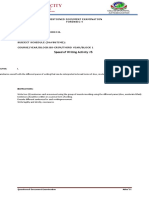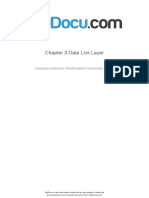Wa-4 Alivio Ul-Fm 1116fm
Wa-4 Alivio Ul-Fm 1116fm
Uploaded by
eselcosacCopyright:
Available Formats
Wa-4 Alivio Ul-Fm 1116fm
Wa-4 Alivio Ul-Fm 1116fm
Uploaded by
eselcosacOriginal Title
Copyright
Available Formats
Share this document
Did you find this document useful?
Is this content inappropriate?
Copyright:
Available Formats
Wa-4 Alivio Ul-Fm 1116fm
Wa-4 Alivio Ul-Fm 1116fm
Uploaded by
eselcosacCopyright:
Available Formats
Technical Bulletin
Model 1116FM (Angle) Fire Pump Pressure Relief Valve
Function
Automatically maintains a constant pressure in the fire protection system by relieving excess pressure.
Features
The WATTS ACV 1116FM (angle) relief valve meets all requirements for UL listed, FM Approved fire protection service. The design and features incorporated in the WATTS ACV valve assure accurate control, dependable performance and long life. Model 116FM: Globe Pattern Single Chamber Relief Valve Model 1116FM: Angle Pattern Single Chamber Relief Valve
Specifications
4 2
3 1 6
Body and Cover: Ductile Iron - ASTM A536 Fusion Bonded Epoxy Coated Seat (trim): Stainless Steel CF8M- Xylan Coated Internals: Stainless Steel AISI 303 or Ductile Iron - ASTM A536 Fusion Bonded Epoxy Coated Stem: Stainless Steel AISI 303 - Xylan Coated Spring: Stainless Steel AISI 302 Elastomers: BUNA- N Control Tubing: Copper Fittings: Brass Pressure Relief Control Body: Bronze SIZES / APPROVALS: 20 - 175 PSI Relief Service 100 - 300 PSI Relief Service Valve Sizes Available in Angle and Globe
CLOSES VALVE OPENS VALVE
FLOW
COMPONENTS
1 - Main Valve (Angle Pattern) 2 - PV20C Relief Control 3 - Fixed Orifice 4 - Pressure Gauge 5 - Check Valve 6 - Flow Clean Strainer
3
UL
4
UL / FM
6
UL / FM
* 8
UL / FM
1116FM
UL
Listed
* 20 - 175 Relief Service Only
Operation
The WATTS ACV Model 1116FM PRESSURE RELIEF VALVE is controlled by a Pressure Relief Control. The Pressure Relief Control is normally closed, held closed by an adjustable spring setting to maintain a constant inlet pressure to the main valve. When upstream pressure increases above the relief set-point, the Relief Control throttles open, increasing flow through the control tubing. Pressure is decreased in the main valve cover chamber, causing the main valve to modulate towards open, relieving excess upstream pressure. The desired system pressure is maintained. As the upstream pressure decreases below the relief set-point, the Relief Control throttles closed, restricting flow through the control tubing. Pressure is increased in the main valve cover chamber, causing the main valve to modulate towards closed, maintaining the desired upstream pressure. Should upstream pressure drop below and remain below the set-point, the main valve closes drip tight.
8550 Hansen Road . Houston, TX 77075 . Telephone 713.943.0688 . Fax 713.944.9445 www.wattsacv.com
DIMENSIONS - ACV 1116FM (Angle)
C
120 150 180 90 60 30 0 210 240 270 300
OUTLET
D
XXXX
XX
TS AT V W AC
A A 150 Outlet 5-3/4 6-3/4 8-1/2 11 300 Outlet 6-1/8 7-1/8 8-15/16 11-1/2
INLET
E B D 300 Inlet 6-1/8 7-1/8 8-15/16 11-1/2 C 5-1/2 5-1/2 4 4 150 Inlet 17-1/2 19-1/4 24-1/2 26-3/4 300 Inlet 17-3/4 19-5/8 25 27-1/4 E 9-1/2 10 11 13 F 7.875 9.97 13.25 16.00
Valve Size Inch - MM 3 - 80 4 - 100 6 - 150 8 - 200
150 Inlet 5-3/4 6-3/4 8-1/2 11
Installation / Start-up Start-up of an Automatic Control Valve requires that proper procedures be followed. Time must be allowed for the valve to react to adjustments and the system to stabilize. The objective is to bring the valve into service in a controlled manner to protect the system from damaging overpressure. NOTE: Avoid mounting valves in a vertical discharge position (valve stem horizontal or cover pointed sideways.) Valves mounted in this position may not perform as tested and approved. - Clear the line of slag and other debris. - Install the valve so that the FLOW ARROW marked on the valve body matches the flow through the line. - Install pressure gauge (supplied) in fitting on valve tubing. Step 1: Turn the Relief Control adjustment screw counterclockwise (out). This lowers the initial relief set-point, allowing the set-point to be increased to the desired setting. Step 2: Loosen a tube fitting at a high point on the valve. This is to allow the cover to vent trapped air during initial filling of the valve. Step 3: Start the pump to supply fluid / pressure to the valve. Step 4: Tighten the tubing when all air is vented from the cover as indicated by continual flow of fluid. NOTE: THE RELIEF SET-POINT SHOULD BE LOWER THAN DESIRED AT THIS TIME. Step 5: Turn the Relief Control adjustment screw clockwise (in) slowly, allowing time for the pressure to gradually increase to the desired set-point.
rev1003
8550 Hansen Road
Houston, TX 77075
Telephone 713.943.0688
Fax 713.944.9445 www.wattsacv.com
MAINTENANCE DISASSEMBLY ASSEMBLY
Maintenance The basic valve, being of packless construction and requiring no lubrication, normally requires a minimum of maintenance. However, it is suggested that a periodic inspection schedule be established to determine how the fluid is affecting the efficiency of the valve. Fluid velocity as well as substances occurring in them such as dissolved minerals and suspended particles, vary in every installation. In areas subject to freezing, remove the body cover drain plugs for winter drain-down. NOTE: The following method will determine if there is a damaged diaphragm without removing the valve cover. Put pressure into the valve and close all control lines to the valve cover chamber. Remove a fitting on the valve cover. If there is a continuous flow our of the cover chamber through this opening, the diaphragm is damaged or the diaphragm assembly on the stem is loose. CAUTION: The valve will be wide open during this procedure. Omit if the fully open valve could result in system damage.
Disassembly / Assembly Inspection or maintenance can be accomplished without removal from the line. To replace the diaphragm and / or the quad ring: 1. Remove fitting nuts where necessary to release the valve cover from the controls or control lines. 2. Remove the cover and spring. 3. Remove the diaphragm and stem assembly taking care not to damage the diaphragm when removing over studs. 4. With the assembly removed, examine the diaphragm and quad ring for wear or damage. Do not disassemble unless replacement is indicated. 5. To replace the diaphragm, quad ring and / or stem o-ring, hold the stem in a vise or with wrench on the flats at the bottom end of the stem. Remove the nuts. 6. Remove the diaphragm wisher, diaphragm, etc. in proper sequence. 7. Check all surfaces, seat, o-ring groves and diaphragm clamping surfaces for damage and / or foreign particles. 8. To reassemble, reverse the order of disassembly. Tighten stem nuts securely to ensure proper clamping of the diaphragm. To assure positive and even clamping of the diaphragm between the body and the cover, gradually tighten the cover nuts diametrically opposite each other.
You might also like
- PASSMEDICINE MCQs-PALLIATIVE CAREDocument22 pagesPASSMEDICINE MCQs-PALLIATIVE CAREImran Chaudhry100% (3)
- Augustine On The TrinityDocument265 pagesAugustine On The TrinityAnton Toth100% (9)
- Common Principles of Couple Therapy 2012 Behavior TherapyDocument11 pagesCommon Principles of Couple Therapy 2012 Behavior TherapyAleexandra SuarezNo ratings yet
- BPDB Assistant Engineer (CSE)Document2 pagesBPDB Assistant Engineer (CSE)Bhoo Oot75% (4)
- Es Acv 1116FMDocument4 pagesEs Acv 1116FMWattsNo ratings yet
- Series V100 Ball ValveDocument20 pagesSeries V100 Ball ValvejenniferNo ratings yet
- Mustang Series M114-2 or M6114-2 (Globe), M1114-2 or M61114-2 (Angle) Installation InstructionsDocument2 pagesMustang Series M114-2 or M6114-2 (Globe), M1114-2 or M61114-2 (Angle) Installation InstructionsWattsNo ratings yet
- Claval PRV TM-90-01Document30 pagesClaval PRV TM-90-01DuxToyNo ratings yet
- Mustang Series M114-8 or M6114-8 (Globe), M1114-8 or M61114-8 (Angle) Installation InstructionsDocument1 pageMustang Series M114-8 or M6114-8 (Globe), M1114-8 or M61114-8 (Angle) Installation InstructionsWattsNo ratings yet
- Stainless Series S114-8 or S6114-8 (Globe), S1114-8 or S61114-8 (Angle) Installation InstructionsDocument1 pageStainless Series S114-8 or S6114-8 (Globe), S1114-8 or S61114-8 (Angle) Installation InstructionsWattsNo ratings yet
- PVR-108-2 Fueling Model SheetDocument2 pagesPVR-108-2 Fueling Model SheetLetycia RosalesNo ratings yet
- Iom WKM 310FDocument4 pagesIom WKM 310FNasir NaqviNo ratings yet
- Sur - Flo Turbine MeterDocument40 pagesSur - Flo Turbine MeterCheng HuangNo ratings yet
- F110-14, F1110-14 Specification SheetDocument6 pagesF110-14, F1110-14 Specification SheetWattsNo ratings yet
- Pressure Relief Valve InspectionDocument18 pagesPressure Relief Valve InspectionZain SallehNo ratings yet
- Valves Gate DamperDocument54 pagesValves Gate DamperLalit MeenaNo ratings yet
- Stainless Series S116-52 or S6116-52 (Globe), S1116-52 or S61116-52 (Angle) Installation InstructionsDocument2 pagesStainless Series S116-52 or S6116-52 (Globe), S1116-52 or S61116-52 (Angle) Installation InstructionsWattsNo ratings yet
- Relief Valves: Gases and Gas EquipmentDocument22 pagesRelief Valves: Gases and Gas EquipmentInspection EngineerNo ratings yet
- Mustang Series M116-52 or M6116-52 (Globe), M1116-52 or M61116-52 (Angle) Installation InstructionsDocument2 pagesMustang Series M116-52 or M6116-52 (Globe), M1116-52 or M61116-52 (Angle) Installation InstructionsWattsNo ratings yet
- Series M Pump - Back Pressure and Relief ValvesDocument12 pagesSeries M Pump - Back Pressure and Relief ValvesvmontoyaNo ratings yet
- W.RT. Reciprocating Air Compressor Explain The Cause of The Following FaultsDocument51 pagesW.RT. Reciprocating Air Compressor Explain The Cause of The Following FaultsSri VasanNo ratings yet
- Stainless Series S115-43 or S6115-43 (Globe), S1115-43 or S61115-43 (Angle) Installation InstructionsDocument2 pagesStainless Series S115-43 or S6115-43 (Globe), S1115-43 or S61115-43 (Angle) Installation InstructionsWattsNo ratings yet
- Classic Series F116-52 (Globe), F1116-52 (Angle) Specification SheetDocument1 pageClassic Series F116-52 (Globe), F1116-52 (Angle) Specification SheetWattsNo ratings yet
- MODEL NR3XL Pressure RegulatorDocument2 pagesMODEL NR3XL Pressure Regulator63ragtopNo ratings yet
- Classic Series F113-19 (Globe), F1113-19 (Angle) Specification SheetDocument1 pageClassic Series F113-19 (Globe), F1113-19 (Angle) Specification SheetWattsNo ratings yet
- Mckenzie CorpDocument8 pagesMckenzie CorpEsau LaHraNo ratings yet
- 5.plant Layout - Relief SystemDocument7 pages5.plant Layout - Relief Systemhalder_kalyan9216100% (1)
- Swing-Flex Check Valve: Operation, Maintenance and Installation ManualDocument8 pagesSwing-Flex Check Valve: Operation, Maintenance and Installation ManualAhmed ShawkyNo ratings yet
- Classic Series F115-58 (Globe), F1115-58 (Angle) Specification SheetDocument1 pageClassic Series F115-58 (Globe), F1115-58 (Angle) Specification SheetWattsNo ratings yet
- Pressure Reducing Valve: ModelDocument2 pagesPressure Reducing Valve: Modeljuliancardona77No ratings yet
- IOM Float Valve ATHENA DN80-100Document11 pagesIOM Float Valve ATHENA DN80-100zaidNo ratings yet
- Mustang Series M115-3 (Globe), M1115-3 (Angle) Specification SheetDocument7 pagesMustang Series M115-3 (Globe), M1115-3 (Angle) Specification SheetWattsNo ratings yet
- Axelson 6Document12 pagesAxelson 6Amit MakwanaNo ratings yet
- Spring Loaded ValvesDocument10 pagesSpring Loaded ValvesKarl NakouziNo ratings yet
- TM 90 21Document21 pagesTM 90 21enrique RiosNo ratings yet
- Cooling Water TowersDocument10 pagesCooling Water Towerssteepa22No ratings yet
- KF Check IOM Series50PistonDocument4 pagesKF Check IOM Series50Pistontilakthakar1No ratings yet
- Iom Gen Truseal 1Document16 pagesIom Gen Truseal 1tsuoscaradrian100% (1)
- Mustang Series M115-11 or M6115-11 (Globe), M1115-11 or M61115-11 (Angle) Specification SheetDocument1 pageMustang Series M115-11 or M6115-11 (Globe), M1115-11 or M61115-11 (Angle) Specification SheetWattsNo ratings yet
- Model 6115-74JM Installation InstructionsDocument2 pagesModel 6115-74JM Installation InstructionsWattsNo ratings yet
- Catálogo Anderson Greenwood 400sDocument32 pagesCatálogo Anderson Greenwood 400sDaniela BeltranNo ratings yet
- ValvesDocument44 pagesValvesأحمد محمد قدريNo ratings yet
- Plant Layout (Relief Valve)Document10 pagesPlant Layout (Relief Valve)Mee WinNo ratings yet
- Series 1156F, T156B and N256 Installation InstructionsDocument2 pagesSeries 1156F, T156B and N256 Installation InstructionsWattsNo ratings yet
- TBV Series 21 20 Cryogenic Flanged Ball ValveDocument5 pagesTBV Series 21 20 Cryogenic Flanged Ball ValveJosip PobranNo ratings yet
- PRV Oil Safety Valve Henry 5600Document3 pagesPRV Oil Safety Valve Henry 5600pm2013No ratings yet
- HansenDocument4 pagesHansenBruna MacedoNo ratings yet
- Inspection & Testing of Pressure Vessels and Pressure Relieving Devices - 4Document7 pagesInspection & Testing of Pressure Vessels and Pressure Relieving Devices - 4DeepakNo ratings yet
- Classic Series F114-2 (Globe), F1114-2 (Angle) Installation InstructionsDocument1 pageClassic Series F114-2 (Globe), F1114-2 (Angle) Installation InstructionsWattsNo ratings yet
- Circuit Setter ManualDocument4 pagesCircuit Setter ManualAnonymous 7xHNgoKE6eNo ratings yet
- TDS010 - 400 Series Pneumatic Actuators Technical DataDocument6 pagesTDS010 - 400 Series Pneumatic Actuators Technical DataRicardoBalderasNo ratings yet
- BPR Valve ManualDocument12 pagesBPR Valve ManualHardip BakaraniyaNo ratings yet
- CLA VAL 50-20-Install-Operation-and-Maintenance-ManualDocument28 pagesCLA VAL 50-20-Install-Operation-and-Maintenance-ManualChirasak PaksasornNo ratings yet
- N-583 Foot ValveDocument1 pageN-583 Foot ValveSầu ĐờiNo ratings yet
- Stainless Series S115-43 or S6115-43 (Globe), S1115-43 or S61115-43 (Angle) Specification SheetDocument1 pageStainless Series S115-43 or S6115-43 (Globe), S1115-43 or S61115-43 (Angle) Specification SheetWattsNo ratings yet
- Classic Series F115-74 (Globe), F1115-74 (Angle) Specification SheetDocument7 pagesClassic Series F115-74 (Globe), F1115-74 (Angle) Specification SheetWattsNo ratings yet
- HD 102 Alarm Valve Model ADocument9 pagesHD 102 Alarm Valve Model AjabbanNo ratings yet
- TM 90 01Document29 pagesTM 90 01juliancardona77No ratings yet
- ACV 113-6RFP Specification SheetDocument4 pagesACV 113-6RFP Specification SheetWattsNo ratings yet
- Mustang Series M115-74 (Globe), M1115-74 (Angle) Specification SheetDocument7 pagesMustang Series M115-74 (Globe), M1115-74 (Angle) Specification SheetWattsNo ratings yet
- InstrDocument31 pagesInstrSergioGaldamesPérezNo ratings yet
- Classic Series F113-41 (Globe), F1113-41 (Angle) Specification SheetDocument1 pageClassic Series F113-41 (Globe), F1113-41 (Angle) Specification SheetWattsNo ratings yet
- Types of Valves in Piping: Types of Valves - Tables to estimate man hours of assemblyFrom EverandTypes of Valves in Piping: Types of Valves - Tables to estimate man hours of assemblyNo ratings yet
- Installation and Operation Instructions For Custom Mark III CP Series Oil Fired UnitFrom EverandInstallation and Operation Instructions For Custom Mark III CP Series Oil Fired UnitNo ratings yet
- KR - MV IDU - R410A - 5060Hz - MFL61741606 - 0CVP0-03A (110503)Document388 pagesKR - MV IDU - R410A - 5060Hz - MFL61741606 - 0CVP0-03A (110503)eselcosac100% (1)
- Cogeneration Class PDFDocument66 pagesCogeneration Class PDFeselcosacNo ratings yet
- Steam Turbine PDFDocument2 pagesSteam Turbine PDFeselcosacNo ratings yet
- Smoke Control TraneDocument156 pagesSmoke Control Traneeselcosac100% (2)
- CeilAiR Engineering ManualDocument76 pagesCeilAiR Engineering Manualeselcosac100% (1)
- Compressed Air Piping Selection and Design - Esl-Ie-05!05!10Document22 pagesCompressed Air Piping Selection and Design - Esl-Ie-05!05!10abvgdzolicNo ratings yet
- Munters General Psych ChartDocument2 pagesMunters General Psych CharteselcosacNo ratings yet
- Diesel Engine Fire Diesel Engine Fire Pump Controllers Pump ControllersDocument4 pagesDiesel Engine Fire Diesel Engine Fire Pump Controllers Pump ControllerseselcosacNo ratings yet
- Technical Data: Release Placement Open StructuresDocument6 pagesTechnical Data: Release Placement Open StructureseselcosacNo ratings yet
- CeilAiR Engineering ManualDocument76 pagesCeilAiR Engineering Manualeselcosac100% (1)
- Valvula de Alivio de PresionDocument4 pagesValvula de Alivio de PresioneselcosacNo ratings yet
- Siamesa Recto Y Siamesa GiacominiDocument8 pagesSiamesa Recto Y Siamesa GiacominieselcosacNo ratings yet
- CeilAiR Engineering ManualDocument76 pagesCeilAiR Engineering Manualeselcosac100% (1)
- Filtro Tipo H x43h EsDocument2 pagesFiltro Tipo H x43h EseselcosacNo ratings yet
- Ielts Score Card PDFDocument1 pageIelts Score Card PDFAarya RaichuraNo ratings yet
- The 2013 New York Book Auction - Kolbe & Fanning Numismatic ...Document126 pagesThe 2013 New York Book Auction - Kolbe & Fanning Numismatic ...Gustavo MazaNo ratings yet
- Employee Performance EvaluationDocument6 pagesEmployee Performance Evaluationsoundar rajNo ratings yet
- National Collateral Management Services Limited: Recruitment of Warehouse Managers/SupervisorsDocument7 pagesNational Collateral Management Services Limited: Recruitment of Warehouse Managers/SupervisorsHriday PrasadNo ratings yet
- ASME B 18.6.5M - 2000 (R2010) Metric Type IA Cross-Recessed Flat Countersunk Head Tapping Screws (Table 10)Document1 pageASME B 18.6.5M - 2000 (R2010) Metric Type IA Cross-Recessed Flat Countersunk Head Tapping Screws (Table 10)Mahmut ErdönmezNo ratings yet
- Ramaswami 02 Yoga Sutra PDFDocument4 pagesRamaswami 02 Yoga Sutra PDFRodrigo Alonso Garrido StuardoNo ratings yet
- NILAI 100%: Jawaban IT Essentials Final Exam 1-10 (V 4.1)Document8 pagesNILAI 100%: Jawaban IT Essentials Final Exam 1-10 (V 4.1)Mimi AlbarwaniNo ratings yet
- Question Bank 3 and 4 UnitDocument8 pagesQuestion Bank 3 and 4 Unitanlacetech133No ratings yet
- Sea of Souls Volume III (Extra Content)Document28 pagesSea of Souls Volume III (Extra Content)Vitor Hugo Sant Ana Vieira (NoName)No ratings yet
- ADHD Coaching-A Practical GuideDocument5 pagesADHD Coaching-A Practical GuideMariano Navarro-Rubio TroisfontainesNo ratings yet
- Cambio de Ubicaciones Sede CuscoDocument62 pagesCambio de Ubicaciones Sede CuscoClinton Maico MezaNo ratings yet
- Project Report. Composite Materials Used On Aircraft WingsDocument15 pagesProject Report. Composite Materials Used On Aircraft WingsYalew MekonnenNo ratings yet
- Poems To MemorizeDocument5 pagesPoems To MemorizeJULIO MANUEL OLIVARESNo ratings yet
- Class 2 Nso 3 Years Sample PaperDocument9 pagesClass 2 Nso 3 Years Sample PaperUmesh75% (4)
- Accent ReductionDocument29 pagesAccent ReductionVishakha NoopurNo ratings yet
- AbortionDocument5 pagesAbortionYlenol HolmesNo ratings yet
- Optical Properties of MaterialsDocument33 pagesOptical Properties of MaterialsHoang Hop Dang100% (1)
- 4 Article TLT Grease AdditivesDocument11 pages4 Article TLT Grease AdditivesYasir ShaikhNo ratings yet
- Write On Care and Maintenance of FabricsDocument8 pagesWrite On Care and Maintenance of FabricsmadhugangulaNo ratings yet
- Chapter 6 Well Completion and StimulationDocument25 pagesChapter 6 Well Completion and StimulationDeniz AkoumNo ratings yet
- Red Hat Enterprise Linux 9 Securing Networks en UsDocument94 pagesRed Hat Enterprise Linux 9 Securing Networks en Usbent vaderNo ratings yet
- Ib HL Aa Textbook Exercises PDFDocument6 pagesIb HL Aa Textbook Exercises PDFapi-369430795100% (1)
- India-China IR Marks Booster HandoutsDocument12 pagesIndia-China IR Marks Booster HandoutsThe PriestNo ratings yet
- Incentive SpirometryDocument5 pagesIncentive Spirometryrachelmores12No ratings yet
- Speed of Writing Activity #5: Questioned Document Examination Forensic 4Document3 pagesSpeed of Writing Activity #5: Questioned Document Examination Forensic 4Gregorio B. SardeñaNo ratings yet
- Chapter 3-Data Link Layer Chapter 3-Data Link LayerDocument48 pagesChapter 3-Data Link Layer Chapter 3-Data Link Layersiva ram krishnaNo ratings yet





































































































